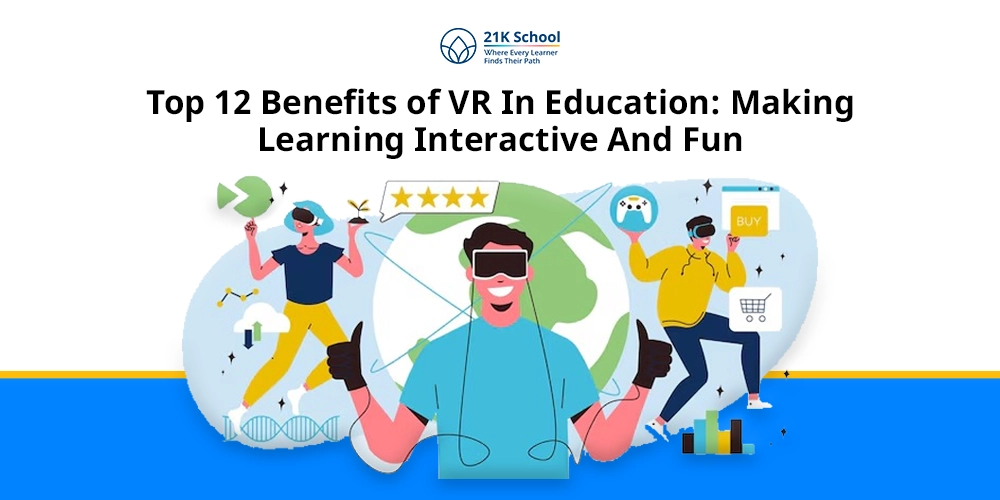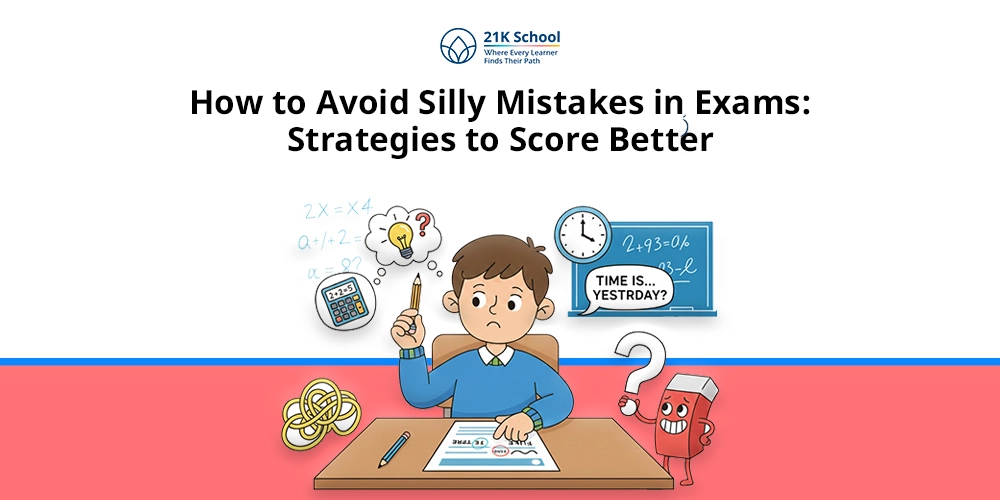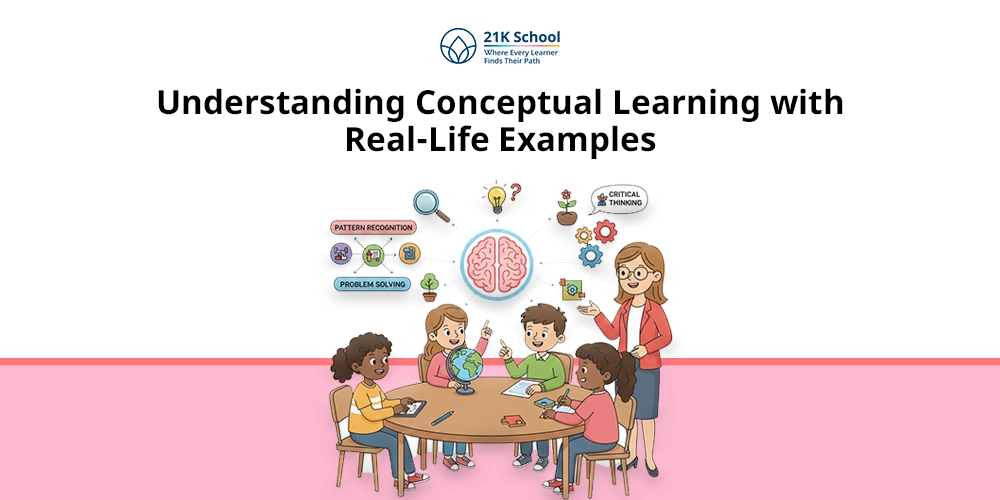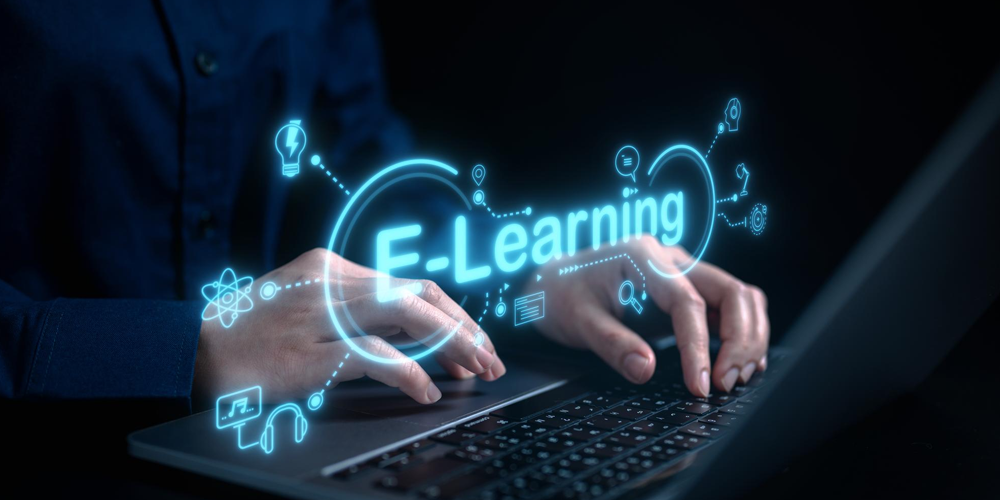
In this dynamic landscape of education, online learning has come out as a revolutionary force, reshaping the way we grab knowledge and skills. In this blog, we will talk about the journey of online education from how it begins to where it has reached these days.
The journey of e-learning is an example of human ingenuity and tireless pursuit of knowledge. Let’s dive deep into the journey through the captivating history of online learning.
Table of Contents
What is e-learning?
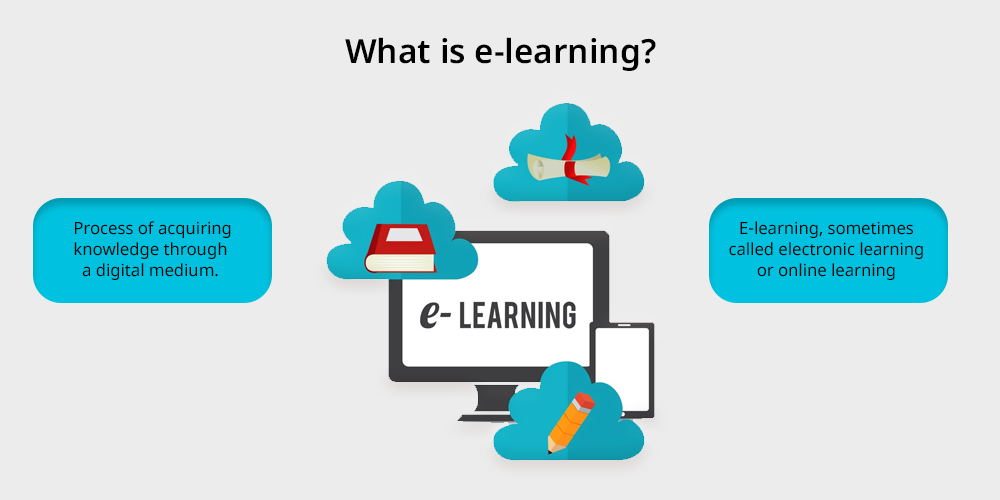
E-learning can be defined as the process of acquiring knowledge through a digital medium.
E-learning, sometimes called electronic learning or online learning, is a method of delivering instructions with the help of technical devices such as Computers, Tablets, Mobile phones, Laptops, etc.
The evolution of e-learning has made education more flexible and effective than traditional learning methods because it allows people to access courses at any time and from any location.
Technology and e-learning techniques are also important for employee professional development in the workplace as well as for student education.
E-learning includes online courses, webinars, video-based learning, simulations and interactive activities.
Early Beginnings: Tracing the Origin of e-learning
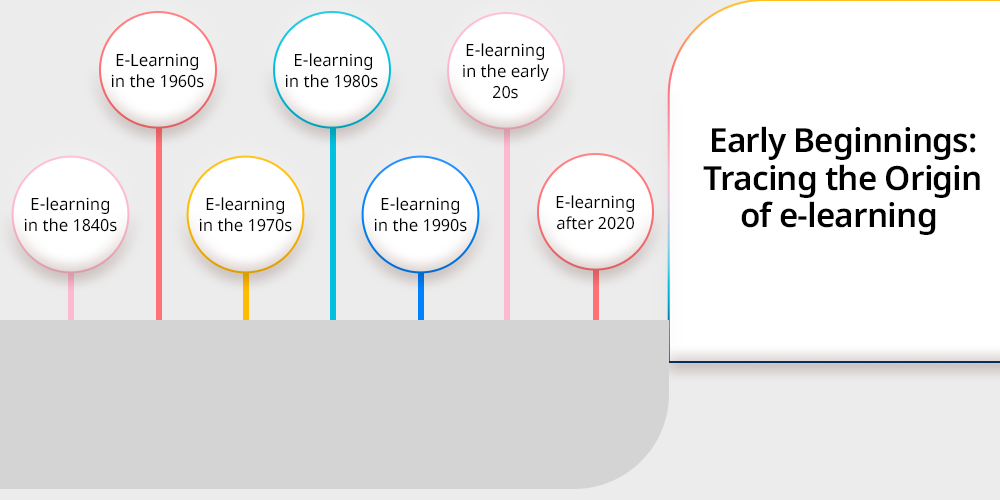
The term e-learning was first described in 1999.
However, e-learning has a very vast history; the earliest educational technologies were introduced in the 1840s by Isaac Pitman, and later on in 1924, Sidney Pressey developed the automatic teacher initiative.
Below, you can check the detailed origin of e-learning.
1. E-learning in the 1840s
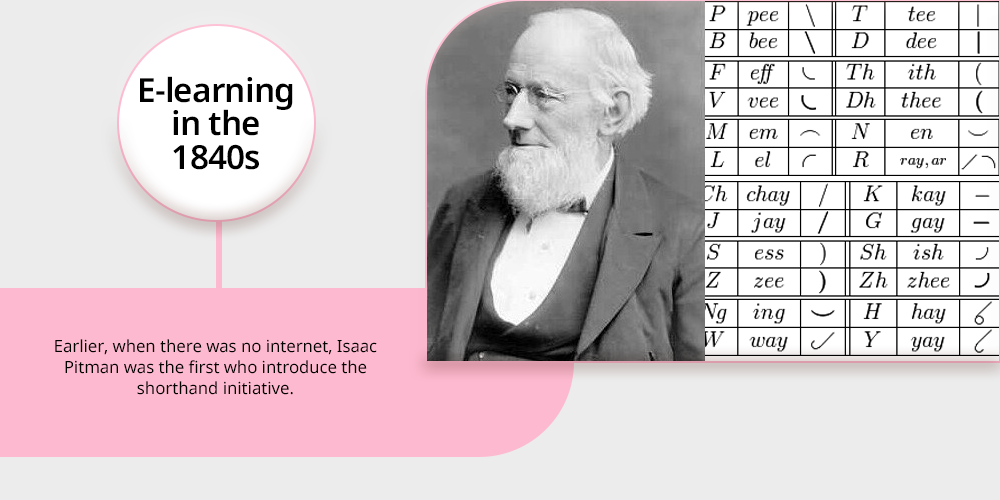
Earlier, when there was no internet, Isaac Pitman was the first who introduce the shorthand initiative.
Shorthand was created to increase the writing speed as a skill set, as at that time it was in high demand. It was widely used by journalists, secretaries, and other people who took or wrote notes.
2. E-Learning in the 1960s
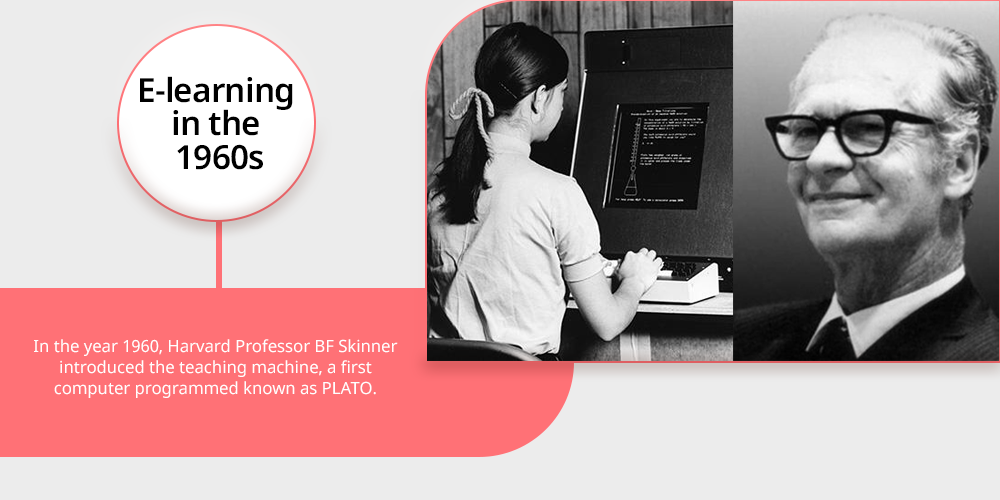
In the year 1960, Harvard Professor BF Skinner introduced the teaching machine, a first computer programmed known as PLATO.
PLATO is a program known for Programmed Logic for Automated Teaching Operations, the main of this program is to promote self-assessment among students.
3. E-learning in the 1970s
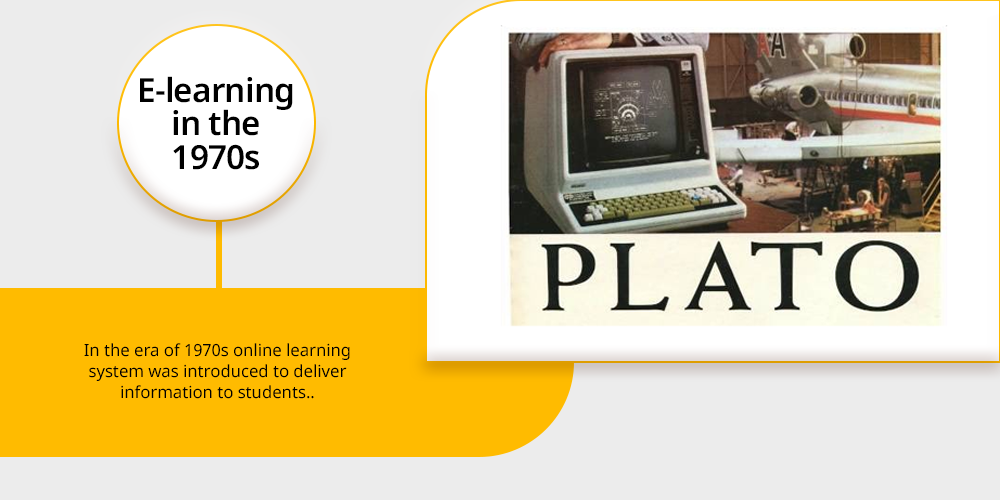
In the era of 1970s online learning system was introduced to deliver information to students. The initiative started from Britain, and open schools were the first to provide e-learning education through a distance mode.
However, at that time, resources were not easily available and due to this, materials and resources were limited to teachers only. At that time, email was used as a primary source for communication.
4. E-learning in the 1980s
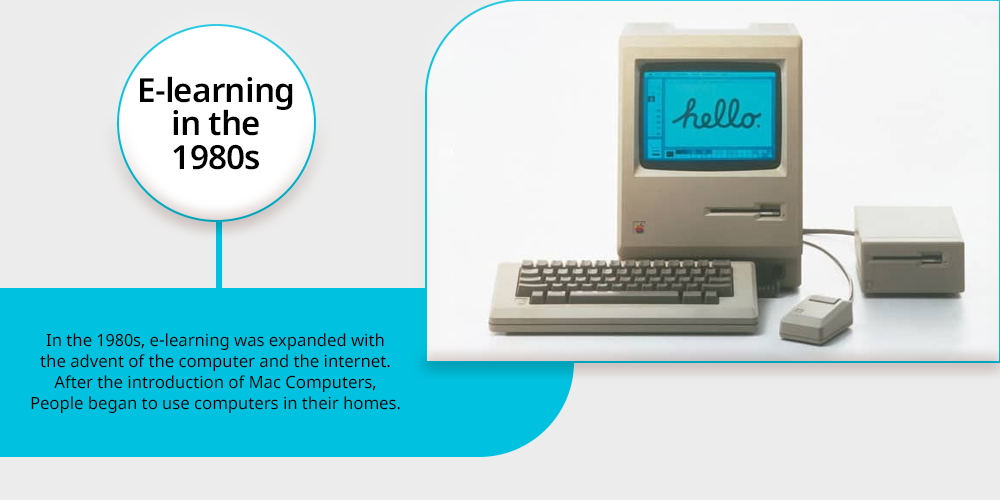
In the 1980s, e-learning was expanded with the advent of the computer and the internet. After the introduction of Mac Computers, People began to use computers in their homes.
Through this, they were able to acquire specific knowledge and skill sets more easily. This enhances a viewpoint for the distance learning opportunities.
5. E-learning in the 1990s
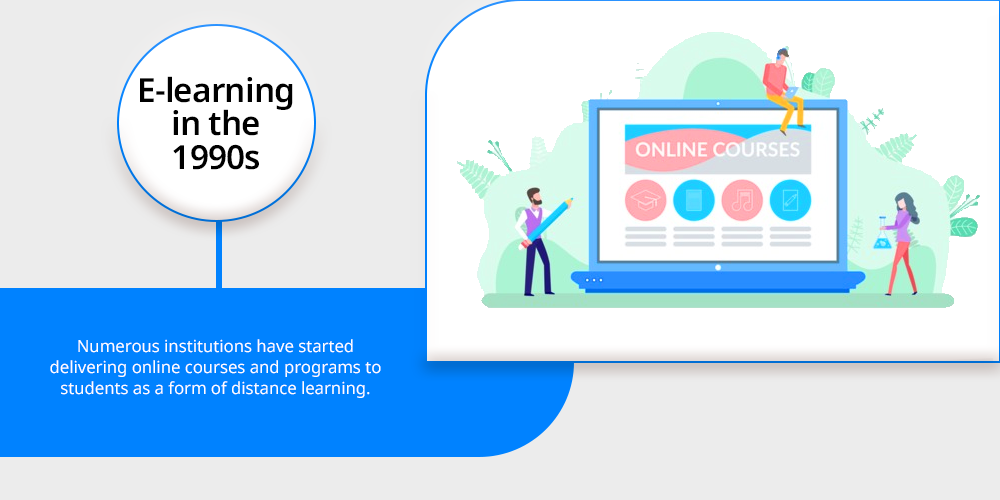
The 1990s were an incredible decade with a full of technology and technical aspects. In 1990, individuals had access to the internet and computers.
Numerous institutions have started delivering online courses and programs to students as a form of distance learning.
This opens wider aspects for colleges and institutions. However, earlier there were not so many positive learning environments due to this it become more challenging to acquire educational resources.
6. E-learning in the early 20s
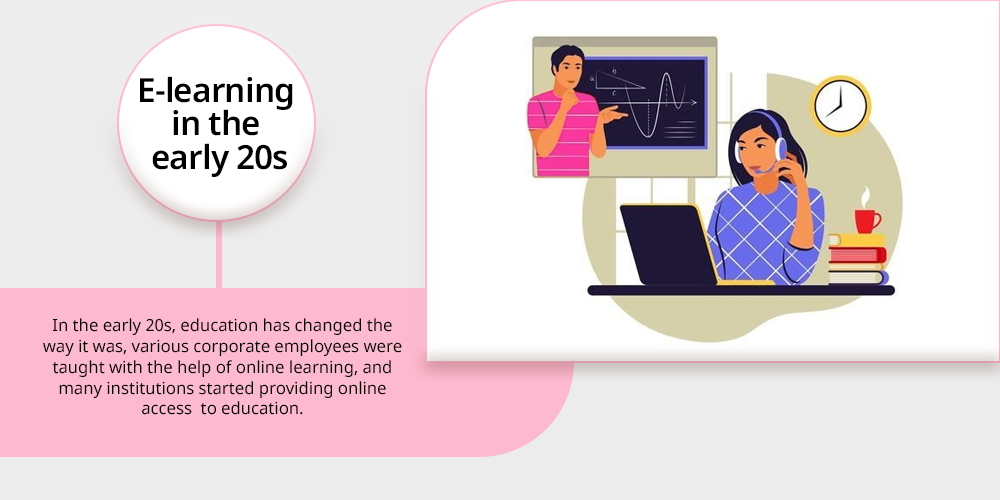
In the early 20s, education has changed the way it was, various corporate employees were taught with the help of online learning, and many institutions started providing online access to education.
E-learning for kids has gain a significant attention during this time, however, providing access to education to kids was a huge challenge at that time.
Through this program individuals can complete their education and achieve their degree from their homes.
7. E-learning after 2020
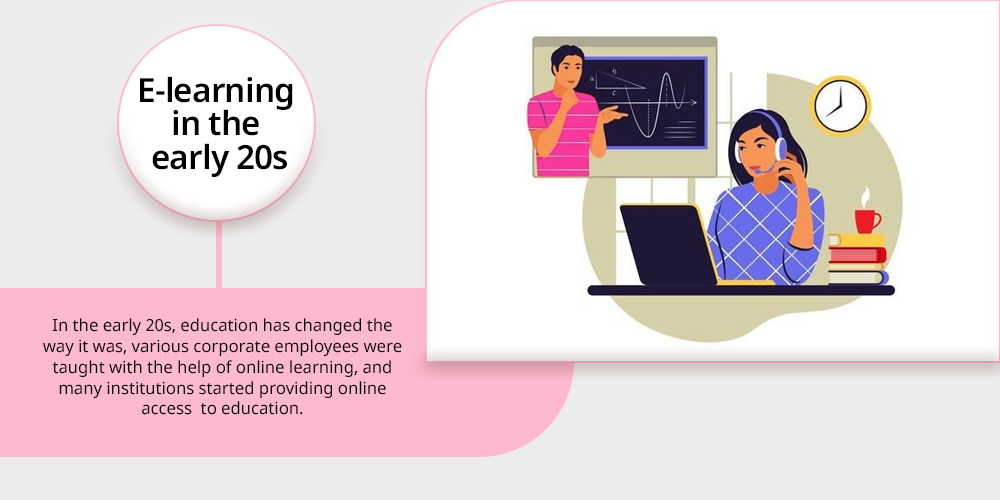
E-learning has changed so much in 2020 during the period of COVID-19. During the covid 19, e-learning has boosted its capabilities, and a maximum number of students adopted the e-learning initiatives.
Even after the end of pandemic, online education is here to stay, because of easy access to educational resources and its benefits.
Education has used so much tech such as AI, AR and VR, LMS and so on to enhance the learning process.
The Origins of E-learning: Rise of Computer-Based Learning
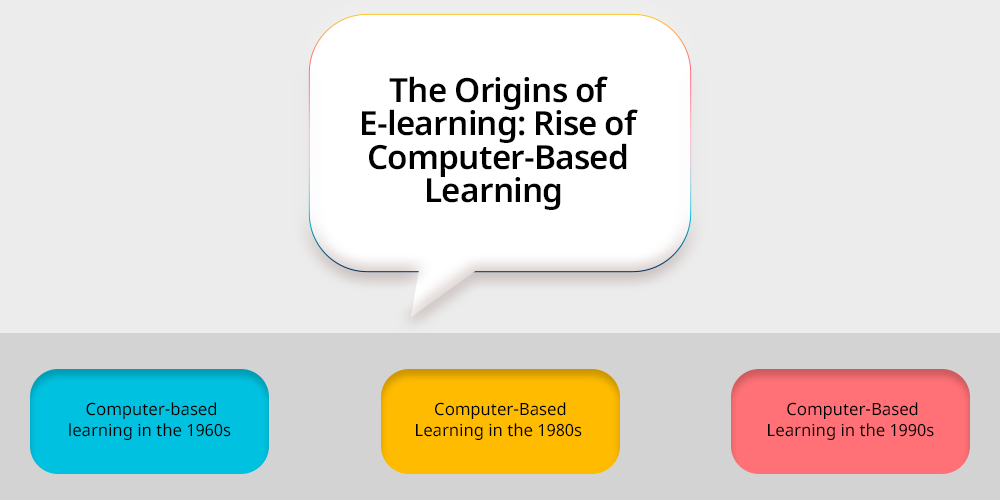
The five generations of computers has gone through a significant change. Computer based training or web-based training were the earliest e-learning methods.
Computer-based training (CBT) was first introduced in the 1960s however, it gained its popularity in the 1980s.
CBT allowed students the flexibility to access training resources on their computers and study at their own pace without the need for an instructor.
Here is how the origins of e-learning started with the rise of computer-based learning, mentioned below.
1. Computer-based learning in the 1960s

The process of computer-based learning was first acknowledged in the year 1960s, and widely used in the 1980s.
CBT or WBT provides easy and comfortable training materials to students through which students can learn at their home by their own without the need of any tutors.
2. Computer-Based Learning in the 1980s
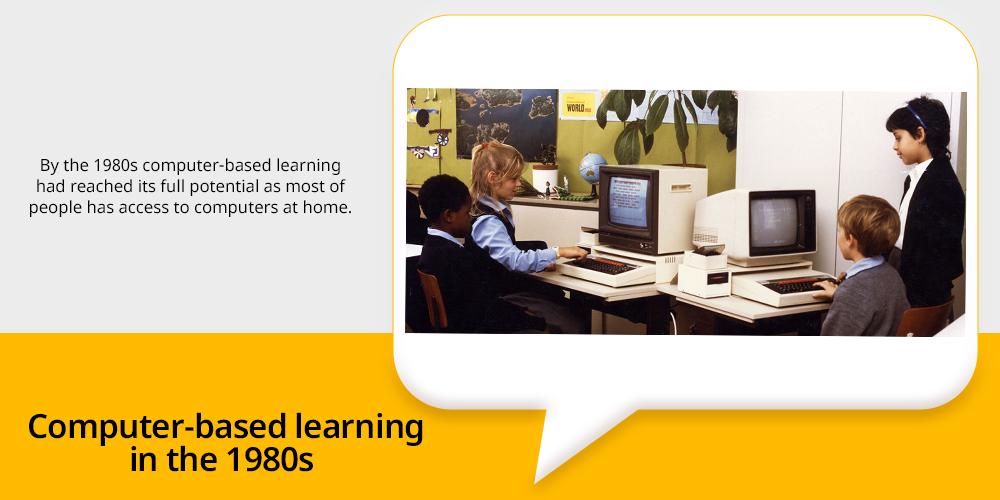
By the 1980s computer-based learning had reached its full potential as most of people has access to computers at home.
With the rise of access various organizations and companies has started providing CBT to their employees remotely.
Later on various educational institutes have also started providing educational resources through CBT.
3. Computer-Based Learning in the 1990s
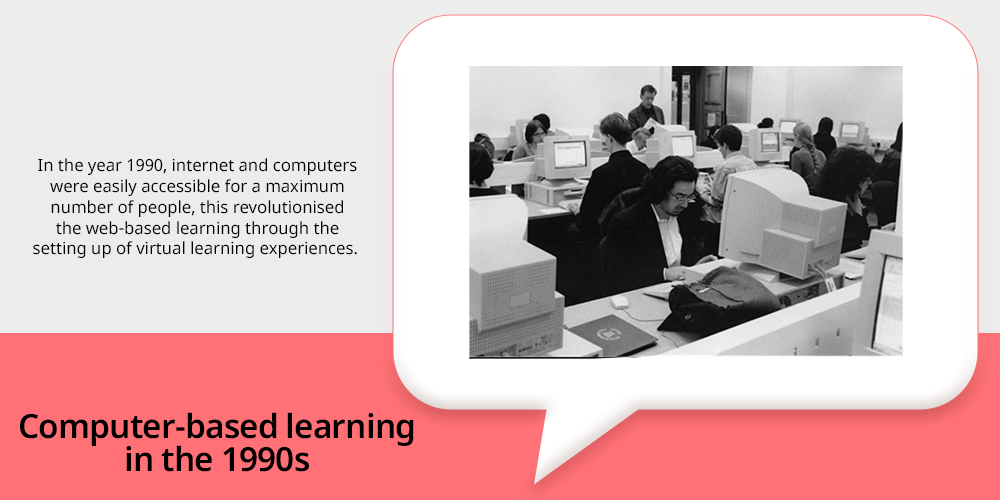
The 1990s have revolutionized the technological landscape.
In the year 1990, internet and computers were easily accessible for a maximum number of people, this revolutionised the web-based learning through the setting up of virtual learning experiences.
Due to this, people can easily access various programs and educational resources. Also at the end of the 1990s, LMS were also introduced, which enhanced the self-learning initiatives of individuals with the help of assessments.
The Advent of the Internet: Evolution of E-Learning
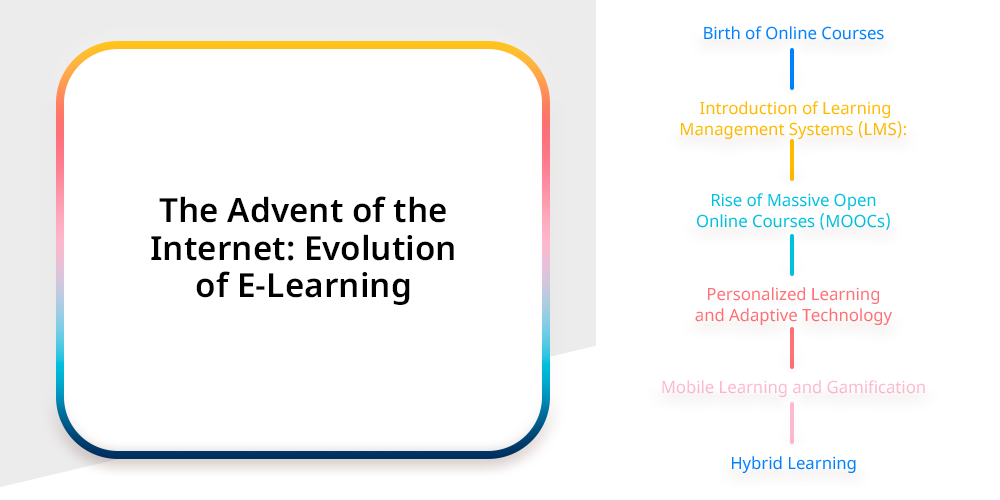
1. Birth of Online Courses:
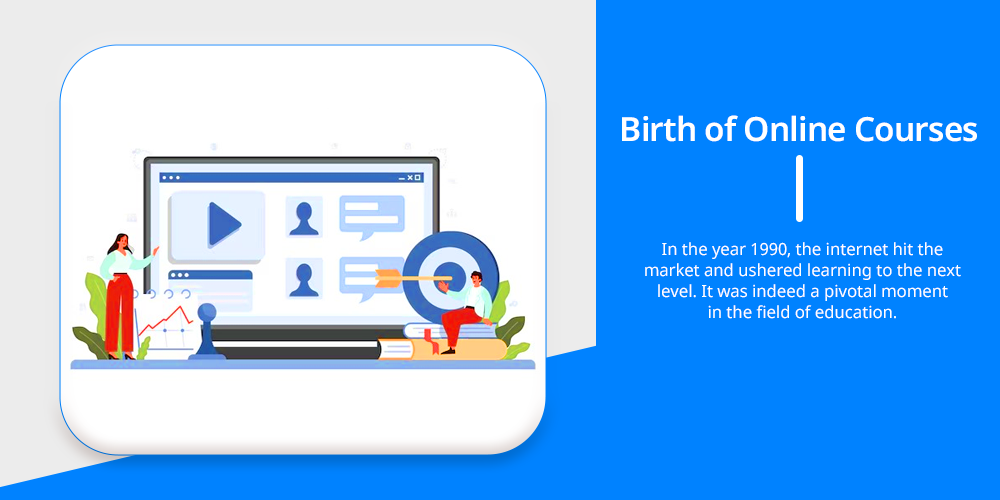
In the year 1990, the internet hit the market and ushered learning to the next level. It was indeed a pivotal moment in the field of education.
A lot of online courses have come to light, interactive learning experiences being offered through several web-based platforms. Students/learners can login to their computer and access a virtual classroom where the educators come up with several course materials and all the fellow students from all over the world.
It was a dreamy moment for all those people of the 90s. No geographical constraints, no time issues, no space problem, as everything had come in your control.
2. Introduction of Learning Management Systems (LMS):
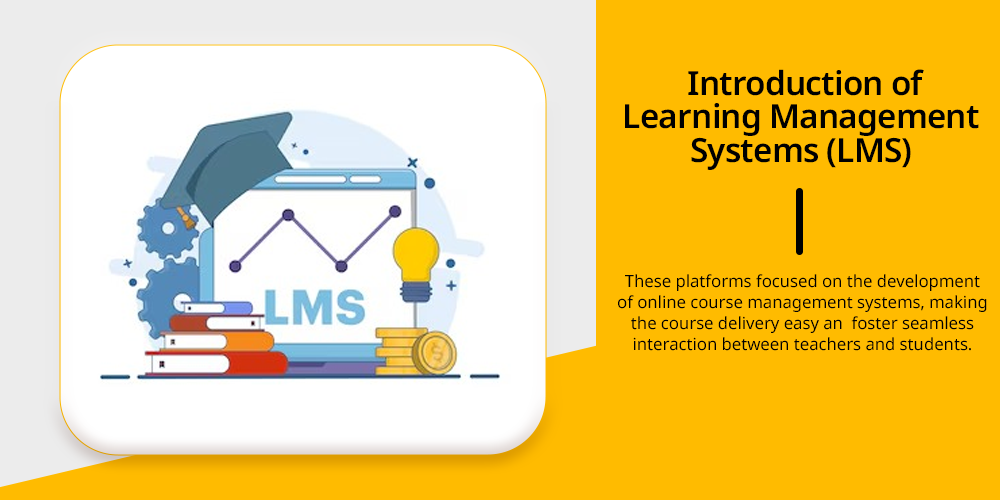
On the one side where online courses were on boom, Learning Management Systems (LMS) like Blackboard and Moodle have fostered the landscape of online education.
These platforms focused on the development of online course management systems, making the course delivery easy and foster seamless interaction between teachers and students.
Just imagine how easy it would be if all the course materials, assignments, and communication tools are very well organized in one digital space, and can be easily accessed as per your favourable time, and from any location.
LMS has undoubtedly revolutionized the educator way of teaching and the student way of learning. It has made education more adaptable to one’s needs.
3. Rise of Massive Open Online Courses (MOOCs):
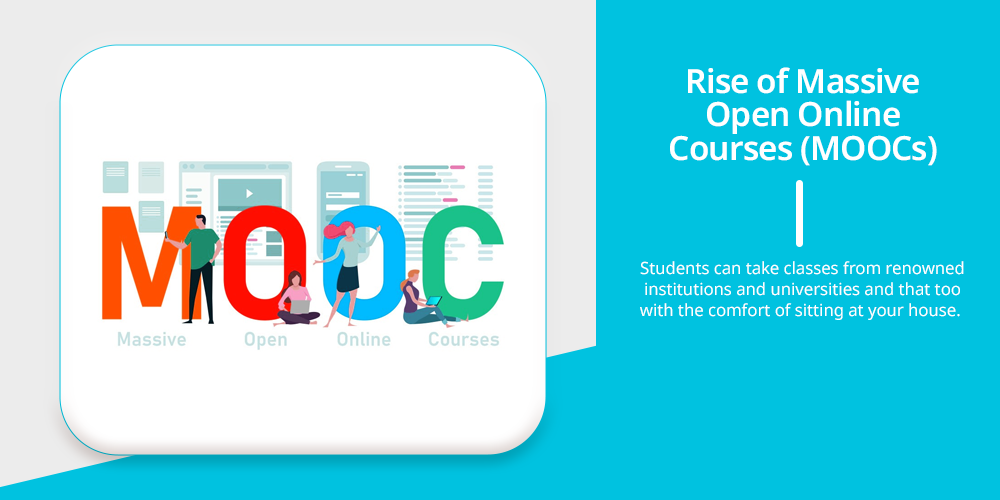
In the early of 2000, the world of learning witnessed a big change with the emergence of Open Online Courses or MOOCs for short.
Students can take classes from renowned institutions and universities and that too with the comfort of sitting at your house.
MOOC Revolution:
In the early 2000, the world of learning witnessed a big change with the emergence of Open Online Courses or Massive Open Online Courses (MOOCs) for short.
Students can take classes from renowned institutions and universities and that too with the comfort of sitting at your house. Students are able to learn from professors at places like Harvard or MIT without any need to be physically available there.
That’s the magic of MOOCs which has made education available not for those elite sections of society but for all those who are needed. It opened the door for everyone.
Accessibility and Affordability:
Another main reason besides the accessibility of education, MOOCs has made it more affordable than ever before.
These courses were available for free sometime or sometimes with a very low price tag which made them a foremost choice for all those who were unable to afford traditional education or in search for flexible options.
No matter what work you do, how busy you are in your life, or where you live, MOOCs have made learning easier than ever. One click and the world is in front of you.
4. Personalized Learning and Adaptive Technology:
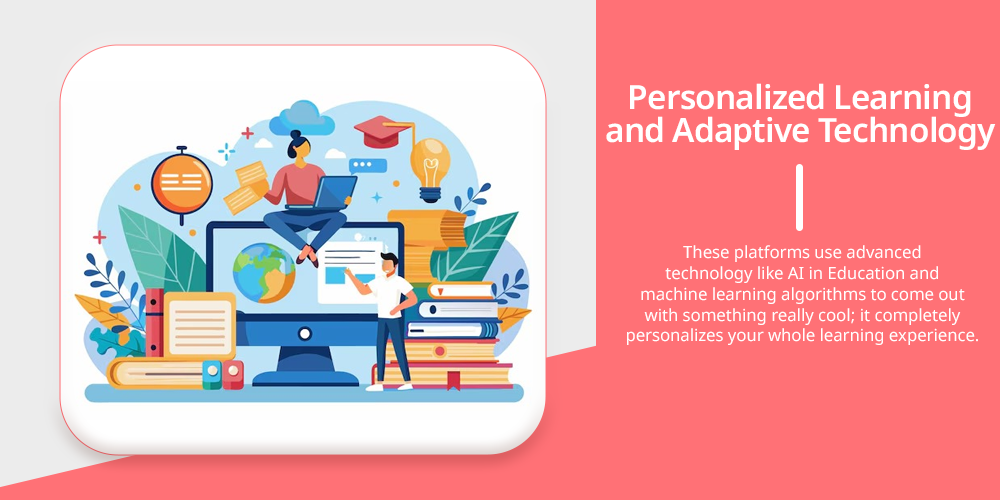
Adaptive Learning Platforms:
Coming to the era we are living in today, we have witnessed something that has never been seen before and more incredible- adaptive learning platforms.
These platforms use advanced technology like AI in Education and machine learning algorithms to come out with something really cool; it completely personalizes your whole learning experience. Didn’t get it? Imagine if all the learning materials adapt to your specific learning style and pace.
This is what adaptive learning is all about. If you want to learn visually, auditory, or some other ways, these platforms give you the content that matches with your preferences.
It is quite similar to have a personal teacher sitting next to you and knowing how to make you learn.
Personalized Learning Paths:
Describing the personalized learning a bit more, we can say students instead of following a one-size fits-all curriculum, they can select the topics they want to learn about and set their personal goal.
For example, if you are someone who is into coding or interested in psychology, with personalized learning paths, they can focus more on the subjects that attract them the most. It’s like building your own path to success.
5. Mobile Learning and Gamification
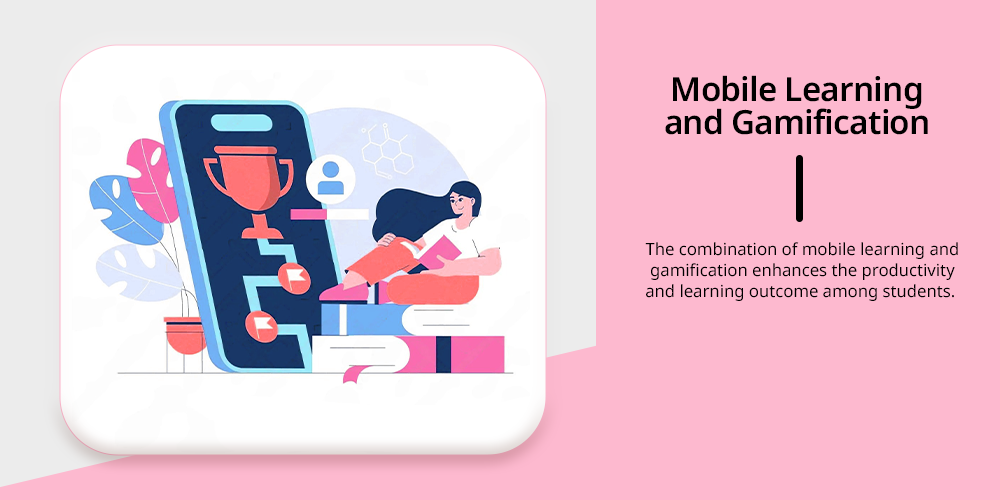
Mobile learning is a procedure of acquiring education through remote learning with the help of mobile phones.
The combination of mobile learning and gamification enhances the productivity and learning outcome among students.
Gamification is the process of using game based learning to make education more motivating and engaging.
It makes use of mobile devices to provide flexible and accessible learning experiences. Online education can be made more engaging and understandable for students with less motivation.
6. Hybrid Learning
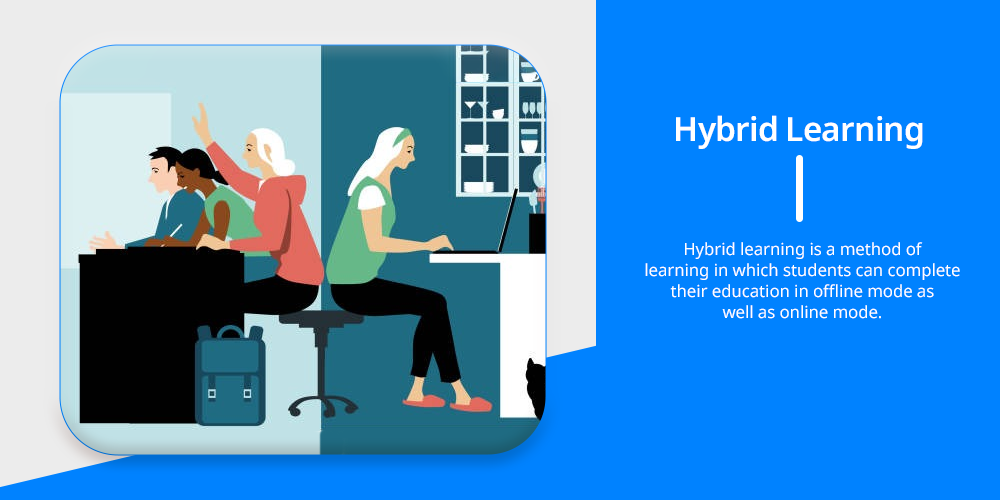
Hybrid learning is a method of learning in which students can complete their education in offline mode as well as online mode. Hybrid learning programs provides flexibility to students as well as creates a synchronization of education.
Basically, in hybrid learning, video classes were presented to students or teachers taught a few students in a regular classroom where as some of them were taught in an online setting.
This learning initiative promotes inclusive learning as well as boosts social skills among students.
Advantages of E-learning
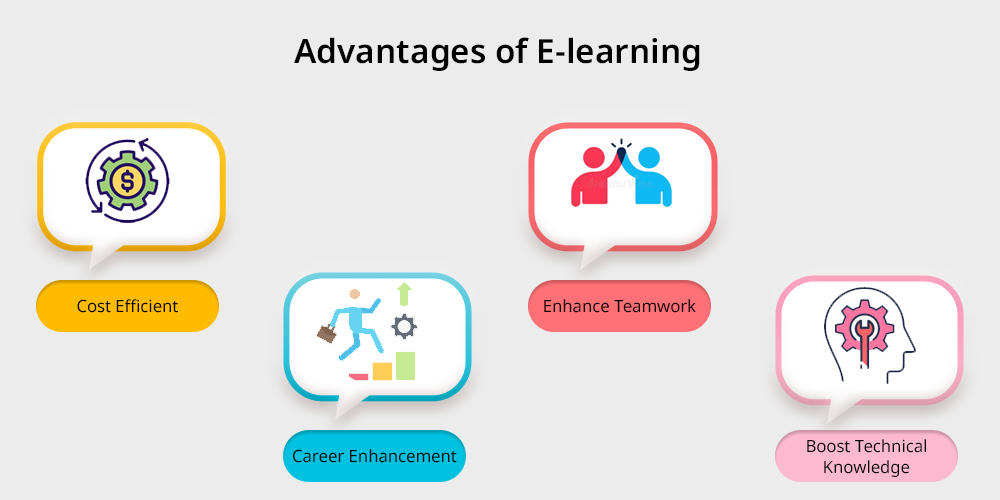
E- learning or online learning is a great initiative to promote holistic development among students.
E-learning is very popular in the 21st century because of its numerous benefits such as flexibility, easy access, cost efficiency, personalized learning and so on. Below you can check the advantages of e-learning.
- Cost Efficient: E-learning or online education has cost effectiveness compared to traditional classrooms. In e-learning there is no extra expenses such as travel expenses, accommodation, library fees, etc. Due to this e e-learning becomes more affordable and cost-efficient.
- Career Enhancement: One of the major advantages of e-learning approach is it helps in career development and skill enhancement. In an online setting, students don’t need to travel or spend 8 long hours studying.
They can continue their study according to their comfort, in the meantime, students can do some skills based education or activities or can give a job interview to enhance their confidence. - Enhance Teamwork: E- learning promotes collaborative learning among students. Students can work together with peers, teacher,s and professionals through online learning and this enhances their teamwork.
- Boost Technical Knowledge: E-learning promotes technical knowledge among students. Since online learning involves the use of technology and technical elements. This enables children to acquire technical skills and digital communications while also helping students comprehend the technological aspects of the subject.
Promotion of 21K School:
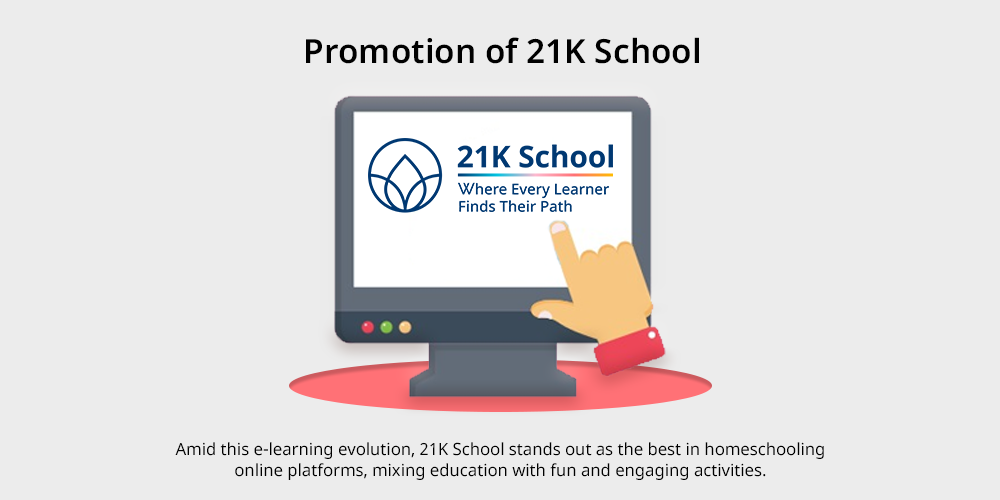
Amid this e-learning evolution, 21K School stands out as the best in homeschooling online platforms, mixing education with fun and engaging activities.
With a wide range of courses and interactive learning modules, they have fulfilled the needs of individuals and take care of the interests of each student. Step into the world of education that has changed the way you learn and the way you grow.
Conclusion:
The evolution of e-learning has transformed the landscape of education, breaking down barriers and expanding access to learning opportunities.
From its humble beginnings to the technological advancements of today, online learning continues to shape the future of education, empowering learners to thrive in a digital world.
The evolution of e-learning has reshaped the landscape of education, eliminates the geographical barriers and expands its access across the world.
From its normal beginning to the technological advancement today, online education is the leading future trend in education, fostering the learners to thrive in a digital world.

